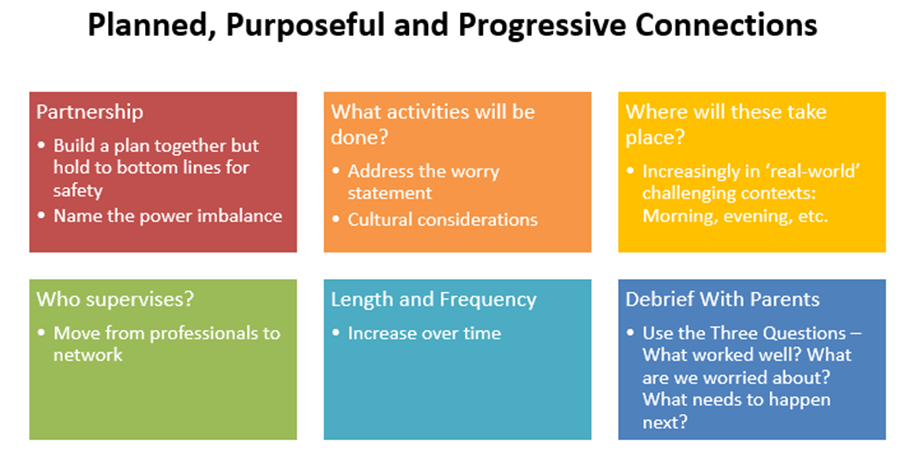Practice prompt
Remember to spend time building relationships between young people, their families and their carers. Positive relationships between these parties will make the young person’s life easier, promote more flexibility in family connection and assist in dealing with practical and emotional challenges.
The following model may be helpful when reviewing or re-establishing contact between the young person and their parents. Consideration of its different aspects can assist with relationships with parents, and with developing the young person’s relationships with their family members.

Wentz, R (2011)
Rebuilding safe family connections through coaching
As young people transition to adulthood, it is important that they be able to maintain relationships in their lives and form new, safe and healthy relationships with family.
Parents and other family members may benefit from a coaching approach to help them re-establish relationships and roles. Consider the following four visit coaching principles to help guide your practice in rebuilding and reconnecting young people with their family.
Empowerment
Guide the family, appreciating the unique ways they show love for their young person. Support them to be leaders when establishing connection with their child.
Sibling connection is key to young people maintaining relationships with family and supports their emotional heath and future wellbeing. Support these connections.
A young person’s connection with family can become a celebration of the family through the sharing of family stories, which contributes to meaningful cultural connection and identity formation.
Empathy
Work to not only understand the young person’s needs, but also to check that the family understands them. Then you can work together to help the young person through their transition to adulthood.
Discuss the impact of the parent’s lifestyle choices on their capacity to meet the young person’s transition needs, do this outside of the quality family connection time.
Responsiveness
Keep the time between the young person and family anger-free. Feelings of anger, sadness or victimisation can get in the way of meeting the young person’s needs.
If you and the family members need to talk, do this separately, to enable the family members to concentrate on the young person during their time together.
Active parenting
Help families to improve the fit between the boundaries that they seek to establish, and the young person’s temperament and behaviour.
Family members can be seen as important role models in the young person’s life and may influence the behaviour of the young person. They need to acknowledge their own negative behaviours that may impact on the young person’s responses and wellbeing.
Beyer, M. (2008). Visit Coaching, reproduced by the Nationally Consistent Collection of Data on School Students with Disability (NCCD) 2014.
Practice prompt
Consider using the Safe Contact Tool to assess the safety level of contact for the young person with family members. Complete this in partnership with the young person. This will help inform their case plan and transition to adulthood plan.
Published on:
Last reviewed:
-
Date:
Maintenance
-
Date:
Maintenance
-
Date:
Page created

